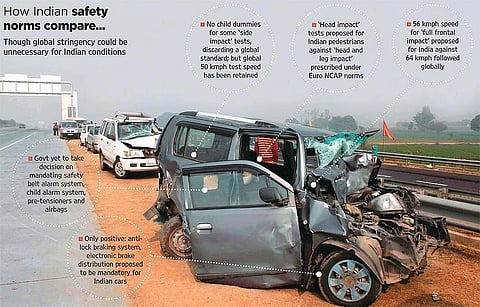The government is trying to water down the safety standards for cars to suit Indian carmakers and Indian conditions. A close examination of the BN VSAP—or Bharat New Vehicle Safety Assessment Programme—reveals that the specifications of many safety standards, including crash tests, have been reduced (or worse eliminated) in the new rules proposed from 2017. This includes a reduced frontal crash test speed; test of impact on different parts of the body; and the use of child dummies in some cases.
We The Crash Test Dummies
Car owners be damned, the government panders to industry on car safety norms
Industry sources say the government accepted BN VASP norms because of the intense pressure from carmakers who felt that if international norms were followed, Indian cars would become significantly more expensive. “One has to take a pragmatic approach here,” says Hormazd Sorabjee, editor, Autocar India. “We have had no norms at all and following global norms will make a large number of budget cars unaffordable.” The Indian car industry has seen low to negative growth in the last few years and prices have increased with the removal of excise duty relief. Any further increase in prices will be counter-productive.
Interestingly, Union road transport and highways minister Nitin Gadkari—who has initiated reforms in the road transport sector, including changes in the registration and licensing system—had only last month said there would be no compromise on safety standards and all cars would have to be fitted with safety features. Yet the new rules will propose to have reduced requirements. Understandably, a government favourably inclined towards industry has come up with standards that would suit carmakers.

The issue of safety standards arose when many popular Indian cars failed the global New Car Assessment Programme (NCAP) crash tests last October. This was the second time after January 2014 that Indian cars had failed the tests. India has so far been following UN regulations and was a signatory to the 1998 agreement along with US, Japan and Europe on road safety requirements.
The government set up a committee in April 2014 to look into the issue. It came out with its report late last year, laying down rules and safety standards for Indian cars. The new rules and crash standards are proposed to come into force from October 1, 2017, for new vehicles and two years later for existing ones.
Obviously, the Indian car industry is united against following global safety standards. Says R.C. Bhargava, chairman, Maruti Suzuki India, “Whatever standards you fix, they should not be blindly copied from Europe, but judged in the context of Indian traffic requirements.” Jnaneswar Sen, senior vice-president, marketing and sales, Honda Cars India, agrees, “We hope that the authorities take the Indian situation into consideration while framing policies.”
Indian carmakers say that since India has a better accident record than many other advanced countries where driving speeds are higher, we do not need a high-speed crash test. Says K.K. Gandhi, director, Society of Indian Automobile Manufacturers (SIAM), “Higher speed crash tests will make the cars safer, but also costlier. At the same time, it could make the drivers more aggressive as they will think that their cars are safer.”
Carmakers feel that looking at the usage pattern of roads, many of the European or global safety standards might not be required in India. Says Bhargava, “It is a little premature to jump to the conclusion that airbags will solve the problem. Nobody has established any link between how many deaths have been caused because a car did not have airbags.” According to him, about 50 per cent of the deaths on the roads in Europe are in cars despite all their safety equipment, including airbags. The corresponding number in India is 16 per cent.
Also, about 30 per cent of the road deaths in India take place on two-wheelers, the number for cars is much lower. Say a Tata Motors spokesperson, “Today, a significant number of road casualties happen outside of the vehicle—two-wheeler and pedestrian-related accidents are a case in point. The ministry is looking at road accidents-related data from different segments to finalise the test protocols and criteria.”
Where does this leave car owners? They have almost no protection in case of manufacturing faults where passenger safety is threatened as manufacturers rarely take responsibility. Says consumer affairs lawyer Jehangir Gai, “The vehicle manufacturers are a powerful lobby and the car owner doesn’t stand a chance in fighting them in such cases.” Gai cites several cases involving leading carmakers where despite manufacturing defects, car owners have found no respite. In some cases, he says, the owner is asked to get his car tested by the Automotive Research Association of India (ARAI) in Pune where the cost of testing is Rs 10-15 lakh or in multiples of the car’s cost.
At present, the country does not have a single crash test facility. Two such facilities—International Centre for Automotive Technology (ICAT) at Manesar and ARAI in Pune—are expected to be ready only by December. Also, globally, there is only one supplier of crash test dummies and there is a huge waiting list. India also does not have the expertise to run these centres. Says Sen, “While the testing facility may be ready by the stipulated time, it would take time to acquire skilled manpower, crash dummies and requisite software for testing.”
Indians are also unwilling to pay extra for safety. Says Mohit Arora, executive director, JD Power Asia Pacific, “Studies show that people have low sensitivity towards high security features. Indian car owners have little desire to have basic safety features like airbags, rear parking assist and rear windscreen wipers.”
With the government planning world-class highways and city roads, driving on Indian roads will change and become like it is abroad. It makes sense for us to be far-sighted and align with global car safety norms than give in to industry’s short-sighted demands.
Tags